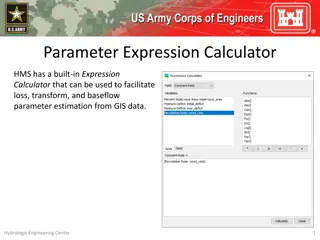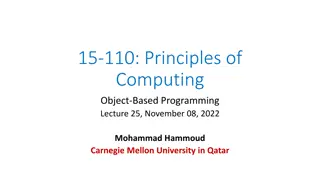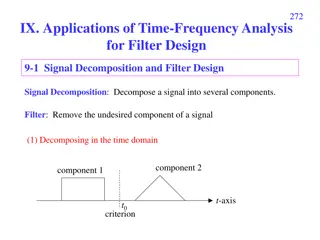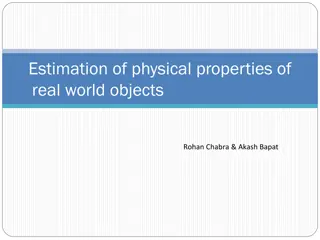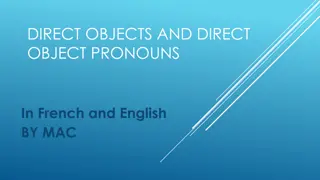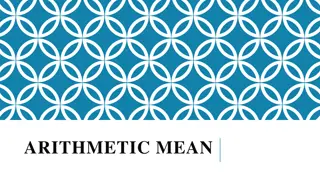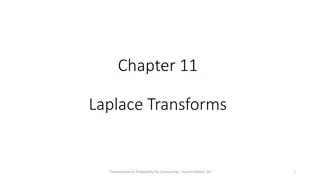A Tutorial on Object Tracking using Mean Transform in Visual Applications
Introduction to object tracking in videos, discussing challenges such as scale, orientation, and location changes. Motivation behind target tracking in surveillance and virtual reality applications. Explanation of a method using sparse coding to modify mean-shift for handling changes in location, scale, and orientation. Achievements in target tracking methods and overview of the tracking algorithm encompassing theory, methods, and algorithms for mean transform tracking.
Download Presentation

Please find below an Image/Link to download the presentation.
The content on the website is provided AS IS for your information and personal use only. It may not be sold, licensed, or shared on other websites without obtaining consent from the author.If you encounter any issues during the download, it is possible that the publisher has removed the file from their server.
You are allowed to download the files provided on this website for personal or commercial use, subject to the condition that they are used lawfully. All files are the property of their respective owners.
The content on the website is provided AS IS for your information and personal use only. It may not be sold, licensed, or shared on other websites without obtaining consent from the author.
E N D
Presentation Transcript
Mean transform , a tutorial KH Wong mean transform v.5a 1
Introduction What is object tracking Track an object in a video, the user gives an initial bounding box Find the bounding box that cover the target pattern in every frame of the video It is difficult because :scale, orientation and location changes mean transform v.5a 2
Motivation Target tracking is useful in surveillance, security and virtual reality applications Examples: Car tracking Human tracking mean transform v.5a 3
Our method We use Sparse coding to Modify mean-shift that handle location, scale, orientation changes Each is a tracking space, combine them together. Ref: Zhe Zhang, Kin Hong Wong, "Pyramid-based Visual Tracking Using Sparsity Represented Mean Transform", IEEE international conference on Computer vision and pattern recognition, CVPR 14, Columbus, Ohio, USA, June 24-27,2014. mean transform v.5a 4
What have been achieved Target tracking method that outperforms many other approaches Show testing result Demo videos mean transform v.5a 5
Overview of the method and algorithm Part 1: Theory and methods Sparse coding, an introduction Mean-shift Location Orientation Scale Histogram calculation Probability calculation (Bhattacharyya coefficient.) Part 2: Mean transform tracking Algorithm mean transform v.5a 6
Part 1 Theory and methods mean transform v.5a 7
Sparse coding A method to extract parameters that represent a pattern. It belongs to the method of L1 compressed sensing ?? Compressed sensing (also known as compressive sensing, compressive sampling, or sparse sampling) is a signal processing technique for efficiently acquiring and reconstructing a signal, by finding solutions tounderdetermined linear systems. (http://en.wikipedia.org/wiki/Compressed_sensing) An alternative is called PCA which uses L2 norm (http://en.wikipedia.org/wiki/Principal_component_analysis) ?? Ref: http://lear.inrialpes.fr/people/mairal/resources/pdf/Grenoble2010.pd f http://www.math.hkbu.edu.hk/~ttang/UsefulCollections/compressed- sensing1.pdf mean transform v.5a 8
Sparse coding programs Spams: http://spams-devel.gforge.inria.fr/ We used the following commands in matlab mexTrainDL (train dictionary) mexLasso mean transform v.5a 9
Dictionary ?? mean transform v.5a 10 http://lear.inrialpes.fr/people/mairal/resources/pdf/Grenoble2010.pdf
Sparse coding operation 32 User select a window Resize X into 32x32 pixels Collect many patches of X, each patch is 16x16, by shifting the patch window Use sparse coding to learn the dictionary D(256*40): You may treat D as a pool of features describing the image X Each patch is a feature. 32 Each patch (red box) is 16x16 pixels 16x16 patches found for training D mean transform v.5a 11
256 because each patch has 256 pixels, hence 256 dimensions for each feature Sparse coding idea D(m=256*p=40) A face has many features Left_eye, right_eye, noise, chin, nose, left ear, right_eye, hair . In theory p=256 because we have 16x16 =256 patches for training, but we drop the unimportant patches (features), and keep only 40 here. It is found by trail-and- error. Image X dictionary D(m*p) If you are given a new unknown picture Y, the sparse coding algorithm would calculate for Y, so Y=D(m*p)* (p*1) (p*1) is the sparse index vector describing the picture Y. It has many zeroes, just highlight the important features E.g. Face measurement= Left_eye*0.2+ right_eye,*0.22+ nose*0.3+ , left ear*0.4+ . If | | is high it is a face , otherwise not. (p*1) has many zeroes, only highlight important features When using Sparse coding , we have two steps, Use an image X to Obtain the dictionary D (mexTrainDL in tracker.m) When a new Y image arrraives, claute coefeictnt | | using 40 mean transform v.5a 12
Our dictionary finding procedures around line 58 of tracker.m For the object window X (32x32), it is first selected by the user Want to track location, scale, orientation of X in subsequent images= what to see if an unknown window contain X or not, check if its has the important features. From Image X (resize to 32x32), represent X based on the combination of patches (each patch =16x16, the red boxes in the diagram). It is achieved by training, so (32-16)*(32-16)=256 patches available for training Use mexTrainDL( ) of Spams (the open source library http://spams-devel.gforge.inria.fr/ to obtain a dictionary (D) of size 256*40 sparse dictionary matrix. 40 is selected arbitrary , found by experiment. In theory you can choose 256 in max but longer than 40 does not increase accuracy X=object window Spams: http://spams-devel.gforge.inria.fr/ mean transform v.5a 13
The meaning of the Dictionary Each column of D is a sparse sample of size linearized 16*16=256? Same size of a patch but linearized to become a vector of 256*1. We can consider Y as a parameter of X I.e. Y256*1=D256*40* 40*1 Y (size 256*1) is the reconstructed image ptach (linearized, can be reshaped back to a 16x16 image) that correspond to the selected ?? The dictionary D (size 256*40)and The sparse index vector (size 40*1), contains many zeroes, that s why it is called sparse coding mean transform v.5a 14
Theory Mean shift See lecture note mean transform v.5a 15
Location transformation mean transform v.5a 16
Rotation transformation mean transform v.5a 17
Scale transformation mean transform v.5a 18
Histogram representation mean transform v.5a 19
Trivial templates mean transform v.5a 20
Pyramid mean transform v.5a 21
Particle filter mean transform v.5a 22
Part 2 The mean-transform tracking algorithm mean transform v.5a 23
Mean transform tracking algorithm see tracker.m Dictionary formation Dictionary and Trivial template for handling lighting change For frame =1 until the last frame Iterate n time (n=5 typical) Form Pyramid Use Particle filter Mean shift for location, scale, orientation mean transform v.5a 24
Our dictionary finding procedures around line 58 of tracker.m For the object window X (32x32), it is first selected by the user Want to track location, scale, orientation of X in subsequent images From Image X (resize to 32x32), represent X based on the combination of patches (each patch =16x16, the red boxes in the diagram). It is achieved by training, so (32- 16)*(32-16)=256 patches available for training Use mexTrainDL( ) of Spams (the open source libaray http://spams-devel.gforge.inria.fr/ to obtain a dictionary (D) of size 256*40 sparse dictionary matrix. 40 is selected arbitrary , found by experiment. In theory you can choose 256 in max but longer than 40 does not increase accuracy X=object window Spams: http://spams-devel.gforge.inria.fr/ mean transform v.5a 25
The meaning of the Dictionary Each column of D is a sparse sample of size linearized 16*16=256? Same size of a patch but linearized to become a vector of 256*1. We can consider Y as a parameter of X I.e. Y256*1=D256*40* 40*1 Y (size 256*1) is the reconstructed image ptach (linearized, can be reshaped back to a 16x16 image) that correspond to the selected ?? The dictionary D (size 256*40)and The sparse index vector (size 40*1), contains many zeroes, that s why it is called sparse coding mean transform v.5a 26
Trivial templates Trivial templates are added to overcome light over exploded images D is 256*40, T is 256*16 -T is 256*16 so the final dictionary D is 256*72 Explain why we use Trivial Templates?? -T=Mostly white with a small black square window T=Mostly black with a small white square window mean transform v.5a 27
Location Mean transform mean transform v.5a 28
Orientation Mean transform mean transform v.5a 29
Scale Mean transform mean transform v.5a 30


